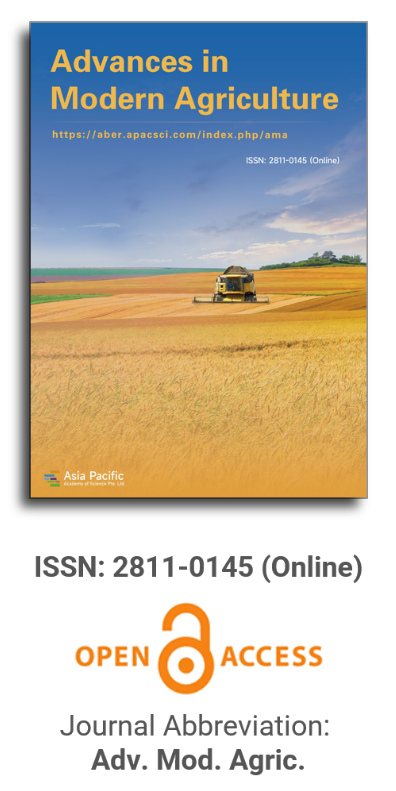


Monitoring the current status of insecticide resistance of field and greenhouse-collected populations of tomato leaf miner Tuta absoluta Meyrick (Lepidoptera: Gelechiidae) in Egypt
Vol 6, Issue 1, 2025
VIEWS - 1111 (Abstract)
Download PDF
Abstract
In order to track changes in developments and the degree of insecticide resistance, some common insecticides used to control T. absoluta in Egyptian fields were examined for seasonal variations in resistance. Tests were designed and tested for a few years at various field sample and greenhouse locations. Ten pesticides were selected for testing, and insects were sampled from eight agricultural fields for the laboratory bioassay. The identification and measurement of resistance in various field populations, seasons, and greenhouses revealed that insects were highly vulnerable to the IGR insecticide tested and only mildly susceptible to OP, Py, carbamate, and nicotinoids. Kalubia and Menufia showed more resistance in terms of both distribution and intensity than Dakahlia, Sharkia, and Giza, which showed lower resistance levels, possibly due to less effective insecticide applications. However, lufenuron was the most effective insecticide, followed by chlorfenapyr (IGRs), methoxyfenzoid, chlorfluazuron, indoxacarb, imidacloprid, cypermethrin, and chlorpyrifos. Dimethoate and spinoteram were the least effective insecticides.
Keywords
References
- Taskin BG, Dogaroglu T, Kilic S, et al. Seasonal dynamics of insecticide resistance, multiple resistance, and morphometric variation in field populations of Culex pipiens. Pesticide Biochemistry and Physiology. 2016; 129: 14–27. doi: 10.1016/j.pestbp.2015.10.012
- Tayeb ESH, Saad AEFA, Elbialy Mahmoud A. Insecticides and Their Mixtures for Controlling Tuta Absoluta Infesting Tomato under Egyptian Field Conditions. Alexandria Science Exchange Journal. 2018; 39(2): 215–222. doi: 10.21608/asejaiqjsae.2018.6814
- Mansour R, Brévault T, Chailleux A, et al. Occurrence, biology, natural enemies and management of Tuta absoluta in Africa. Entomologia Generalis. 2018; 38(2): 83–112. doi: 10.1127/entomologia/2018/0749
- Cely PL, Cantor F, Rodríguez D. Determination of levels of damage caused by different densities of Tuta absoluta populations (Lepidoptera: Gelechiidae) under greenhouse conditions. Agronomía Colombiana. 2010; 28(3): 401–411.
- Arnó J, Gabarra R. Side effects of selected insecticides on the Tuta absoluta (Lepidoptera: Gelechiidae) predators Macrolophus pygmaeus and Nesidiocoris tenuis (Hemiptera: Miridae). Journal of Pest Science. 2011; 84(4): 513–520. doi: 10.1007/s10340-011-0384-z
- Galdino TVS, Picanco MC, Ferreira DO, et al. Is the performance of a specialist herbivore affected by female choices and the adaptability of the offspring? PloS One. 2015; 10(11): 1–18. doi: 10.1371/journal. pone.0143389
- Guedes RNC, Picanço MC. The tomato borer Tuta absoluta in South America: pest status, management and insecticide resistance. EPPO Bulletin. 2012; 42(2): 211–216. doi: 10.1111/epp.2557
- Moussa S, Sharma A, Baiomy F, et al. The Status of Tomato Leafminer; Tuta absoluta (Meyrick) (Lepidoptera: Gelechiidae) in Egypt and Potential Effective Pesticides. Academic Journal of Entomology. 2013; 6(3): 110–115. doi: 10.5829/idosi.aje.2013.6.3.75130
- Silva GA, Picanço MC, Bacci L, et al. Control failure likelihood and spatial dependence of insecticide resistance in the tomato pinworm, Tuta absoluta. Pest Management Science. 2011; 67(8): 913–920. doi: 10.1002/ps.2131
- Silva WM, Berger M, Bass C, et al. Status of pyrethroid resistance and mechanisms in Brazilian populations of Tuta absoluta. Pesticide Biochemistry and Physiology. 2015; 122: 8–14. doi: 10.1016/j.pestbp.2015.01.011
- Nozad-Bonab Z, Hejazi MJ, Iranipour Sh, et al. Lethal and Sublethal Effects of Some Chemical and Biological Insecticides on Tuta absoluta (Lepidoptera: Gelechiidae) Eggs and Neonates. Journal of Economic Entomology. 2017; 110(3): 1138–1144. doi: 10.1093/jee/tox079
- Campos MR, Rodrigues ARS, Silva WM, et al. Spinosad and the Tomato Borer Tuta absoluta: A Bioinsecticide, an Invasive Pest Threat, and High Insecticide Resistance. PLoS ONE. 2014; 9(8): e103235. doi: 10.1371/journal.pone.0103235
- Roditakis E, Vasakis E, Grispou M, et al. First report of Tuta absoluta resistance to diamide insecticides. Journal of Pest Science. 2015; 88(1): 9–16. doi: 10.1007/s10340-015-0643-5
- Gontijo PC, Picanço MC, Pereira EJG, et al. Spatial and temporal variation in the control failure likelihood of the tomato leaf miner, Tuta absoluta. Annals of Applied Biology. 2012; 162(1): 50–59. doi: 10.1111/aab.12000
- Hribar LJ, Boehmler MB, Murray HL, et al. Mosquito Surveillance and Insecticide Resistance Monitoring Conducted by the Florida Keys Mosquito Control District, Monroe County, Florida, USA. Insects. 2022; 13: 927. doi: 10.3390/ insects13100927
- Yainna S, Nègre N, Silvie PJ, et al. Geographic Monitoring of Insecticide Resistance Mutations in Native and Invasive Populations of the Fall Armyworm. Insects. 2021; 12(5): 468. doi: 10.3390/insects12050468
- Lopez‐Monroy B, Gutierrez‐Rodriguez SM, Villanueva‐Segura OK, et al. Frequency and intensity of pyrethroid resistance through the CDC bottle bioassay and their association with the frequency of kdr mutations in Aedes aegypti (Diptera: Culicidae) from Mexico. Pest Management Science. 2018; 74(9): 2176–2184. doi: 10.1002/ps.4916
- Reyes M, Rocha K, Alarcón L, et al. Metabolic mechanisms involved in the resistance of field populations of Tuta absoluta (Meyrick) (Lepidoptera: Gelechiidae) to spinosad. Pesticide Biochemistry and Physiology. 2012; 102(1): 45–50. doi: 10.1016/j.pestbp.2011.10.008
- Hassan ESM, Mesbah II, Ali FA, et al. Prevalence, population dynamics and associated natural enemies of Tomato Leafminer, Tuta absoluta, in Egypt. International Journal of Tropical Insect Science. 2021; 42(1): 143–162. doi: 10.1007/s42690-021-00526-3
- Finney DJ. Probit analysis, 3rd ed. Cambridge unio press; 1971.
- Abbott WS. A Method of Computing the Effectiveness of an Insecticide. Journal of Economic Entomology. 1925; 18(2): 265–267. doi: 10.1093/jee/18.2.265a
- Russell RM, Robertson JL, Savin NE. POLO: A New Computer Program for Probit Analysis. Bulletin of the Entomological Society of America. 1977; 23(3): 209–213. doi: 10.1093/besa/23.3.209
- Robertson JL, Preisler HK. Pesticide bioassays with arthropods. CRC Press; 1992.
- Larraín P, Escudero C, Morre J, et al. Insecticide effect of cyantraniliprole on tomato moth Tuta absoluta Meyrick (Lepidoptera: Gelechiidae) larvae in field trials. Chilean journal of agricultural research. 2014; 74(2): 178–183. doi: 10.4067/s0718-58392014000200008
- De Smedt C, Van Damme V, De Clercq P, et al. Insecticide Effect of Zeolites on the Tomato Leafminer Tuta absoluta (Lepidoptera: Gelechiidae). Insects. 2016; 7(4): 72. doi: 10.3390/insects7040072
- Mikhail W, Sobhy H, Gaffar S, et al. Evaluation Effectiveness of Some Insecticides in Controlling Tomato Leafminer, Tuta. absoluta in the Lab. Egyptian Academic Journal of Biological Sciences, F Toxicology & Pest Control. 2016; 8(2): 51–61. doi: 10.21608/eajbsf.2016.17118
- Jin JX, Jin DC, Li WH, et al. Monitoring Trends in Insecticide Resistance of Field Populations of Sogatella furcifera (Hemiptera: Delphacidae) in Guizhou Province, China, 2012–2015. Journal of Economic Entomology. 2017; 110(2): 641–650. doi: 10.1093/jee/tox027
- Devillers J, David JP, Barrès B, et al. Integrated Plan of Insecticide Resistance Surveillance in Mosquito Vectors in France. Insects. 2023; 14(5): 457. doi: 10.3390/insects14050457
- Erdogan C, Toprak U, Gurkan MO. Biochemical and molecular analyses of insecticide resistance in greenhouse populations of Bemisia tabaci (Hemiptera: Aleyrodidae) in Türkiye. Phytoparasitica. 2024; 52(2). doi: 10.1007/s12600-024-01155-5
- Lietti MMM, Botto E, Alzogaray RA. Insecticide resistance in Argentine populations of Tuta absoluta (Meyrick) (Lepidoptera: Gelechiidae). Neotropical Entomology. 2005; 34(1): 113–119. doi: 10.1590/s1519-566x2005000100016
- Guillemaud T, Blin A, Le Goff I, et al. The tomato borer, Tuta absoluta, invading the Mediterranean Basin, originates from a single introduction from Central Chile. Scientific Reports. 2015; 5(1). doi: 10.1038/srep08371
- Santos AC, Freitas Bueno RCO, Vieira SS, et al. Efficiency of insecticides on Tuta absoluta (Meyrick) and other tomato pests. Bioassay. 2011; 6(0). doi: 10.14295/ba.v6.0.81
- Giorgini M, Guerrieri E, Cascone P, et al. Current Strategies and Future Outlook for Managing the Neotropical Tomato Pest Tuta absoluta (Meyrick) in the Mediterranean Basin. Neotropical Entomology. 2018; 48(1): 1–17. doi: 10.1007/s13744-018-0636-1
- Han P, Zhang Y, Lu Z, et al. Are we ready for the invasion of Tuta absoluta? Unanswered key questions for elaborating an Integrated Pest Management package in Xinjiang, China. Entomologia Generalis. 2018; 38(2): 113–125. doi: 10.1127/entomologia/2018/0739
- Silva GA, Queiroz EA, Arcanjo LP, et al. Biological performance and oviposition preference of tomato pinworm Tuta absoluta when offered a range of Solanaceous host plants. Scientific Reports. 2021; 11(1). doi: 10.1038/s41598-020-80434-7
- Karut K, Kazak C, Döker I, et al. Pest status and prevalence of tomato moth Tuta absoluta (Meyrick 1917) (Lepidoptera: Gelechiidae) in tomato growing greenhouses of Mersin. Turkish journal of entomology. 2011; 35: 339–347.
- Samake JN, Yared S, Hassen MA, et al. Insecticide resistance and population structure of the invasive malaria vector, Anopheles stephensi, from Fiq, Ethiopia. Scientific Reports. 2024; 14(1). doi: 10.1038/s41598-024-78072-4
- Kishore Reddy BK, Sadhineni M, Johnson M, et al. Evaluation of Insecticides against Pin Worm Tuta absoluta (Meyrick) on Tomato. Indian Journal of Entomology. 2024: 1–3. doi: 10.55446/ije.2024.1689
- Van Damme V, Berkvens N, Moerkens R, et al. Overwintering potential of the invasive leafminer Tuta absoluta (Meyrick) (Lepidoptera: Gelechiidae) as a pest in greenhouse tomato production in Western Europe. Journal of Pest Science. 2014; 88(3): 533–541. doi: 10.1007/s10340-014-0636-9
Supporting Agencies
Agricultural research center
Copyright (c) 2025 Hanan Salah El-Din Taha
License URL: https://creativecommons.org/licenses/by/4.0/

This site is licensed under a Creative Commons Attribution 4.0 International License (CC BY 4.0).

Prof. Zhengjun Qiu
Zhejiang University, China

Cheng Sun
Academician of World Academy of Productivity Science; Executive Chairman, World Confederation of Productivity Science China Chapter, China
Indexing & Archiving
In the realm of modern agriculture, the integration of cutting-edge technologies is revolutionizing the way we approach sustainable farming practices. A recent study published in Advances in Modern Agriculture titled "Classification of cotton water stress using convolutional neural networks and UAV-based RGB imagery" has garnered significant attention for its innovative approach to precision irrigation management. Conducted by researchers from Institute of Data Science and the AgriLife Research and Extension Center of Texas A&M University (authors's information is below). This study introduces a novel method for classifying cotton water stress using unmanned aerial vehicles (UAVs) and convolutional neural networks (CNNs), offering a powerful solution for optimizing water use in agriculture.
Modern agricultural technology is evolving rapidly, with scientists collaborating with leading agricultural enterprises to develop intelligent management practices. These practices utilize advanced systems that provide tailored fertilization and treatment options for large-scale land management.
This journal values human initiative and intelligence, and the employment of AI technologies to write papers that replace the human mind is expressly prohibited. When there is a suspicious submission that uses AI tools to quickly piece together and generate research results, the editorial board of the journal will reject the article, and all journals under the publisher's umbrella will prohibit all authors from submitting their articles.
Readers and authors are asked to exercise caution and strictly adhere to the journal's policy regarding the usage of Artificial Intelligence Generated Content (AIGC) tools.
Asia Pacific Academy of Science Pte. Ltd. (APACSCI) specializes in international journal publishing. APACSCI adopts the open access publishing model and provides an important communication bridge for academic groups whose interest fields include engineering, technology, medicine, computer, mathematics, agriculture and forestry, and environment.



.jpg)
.jpg)

.jpg)
